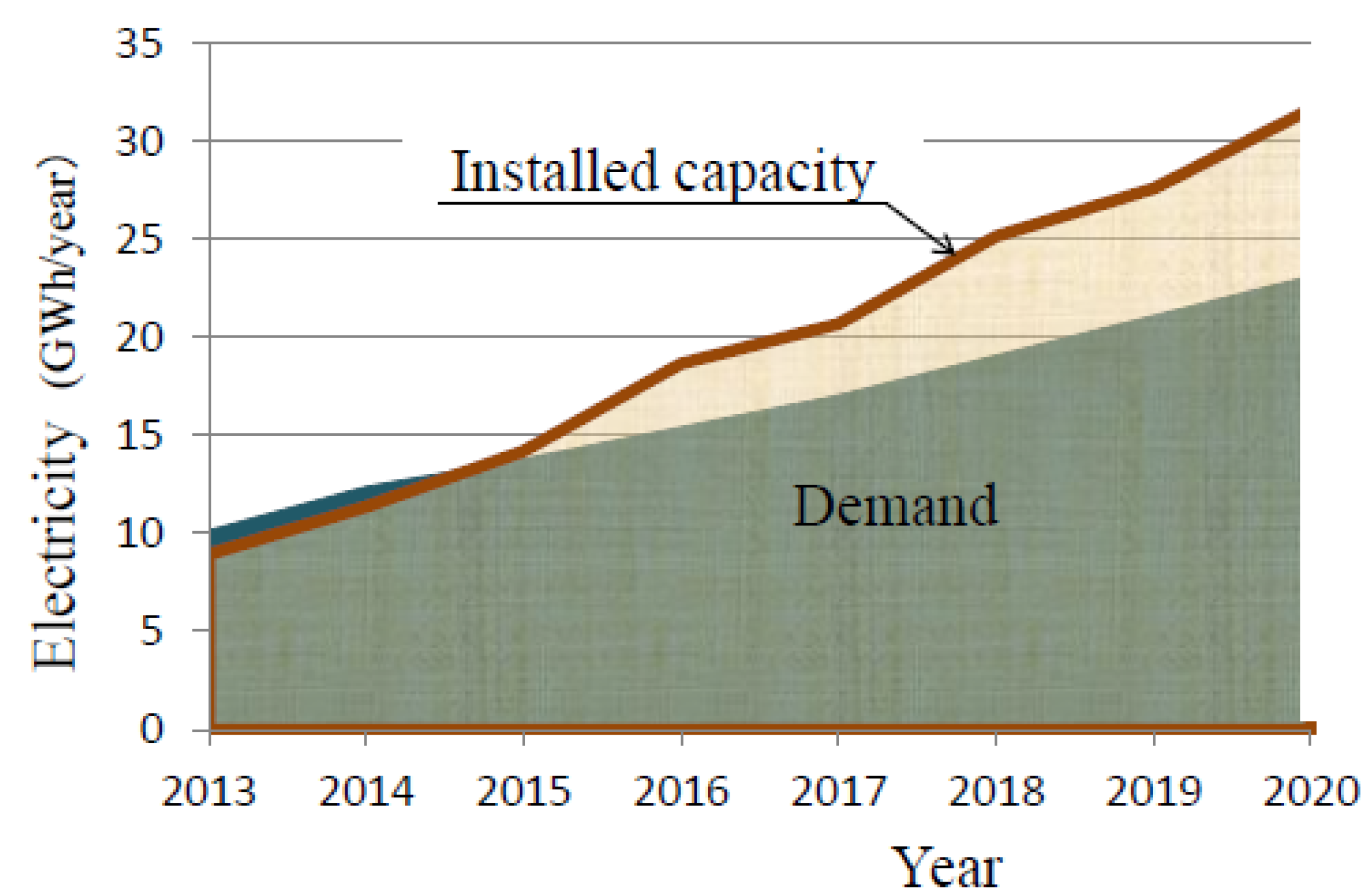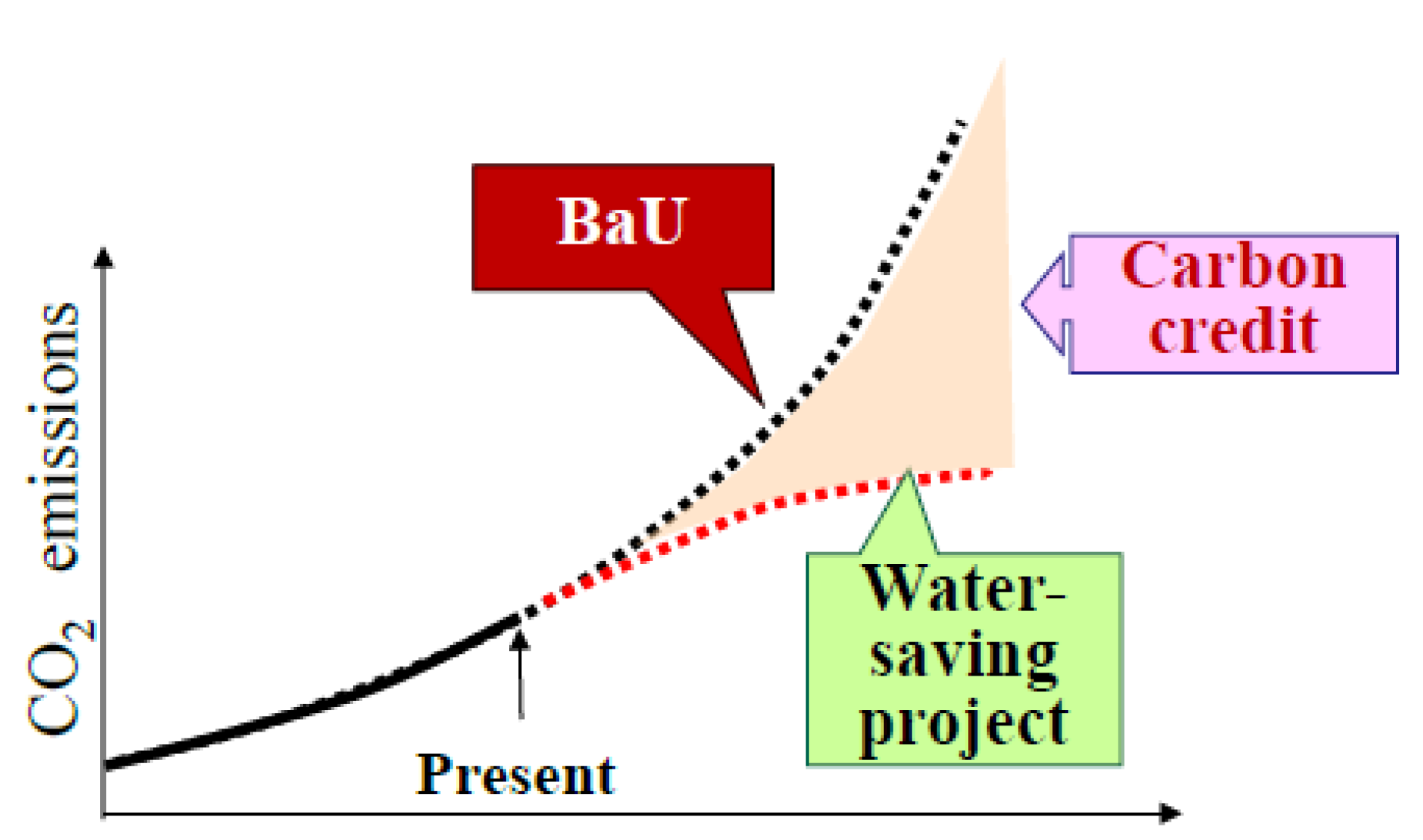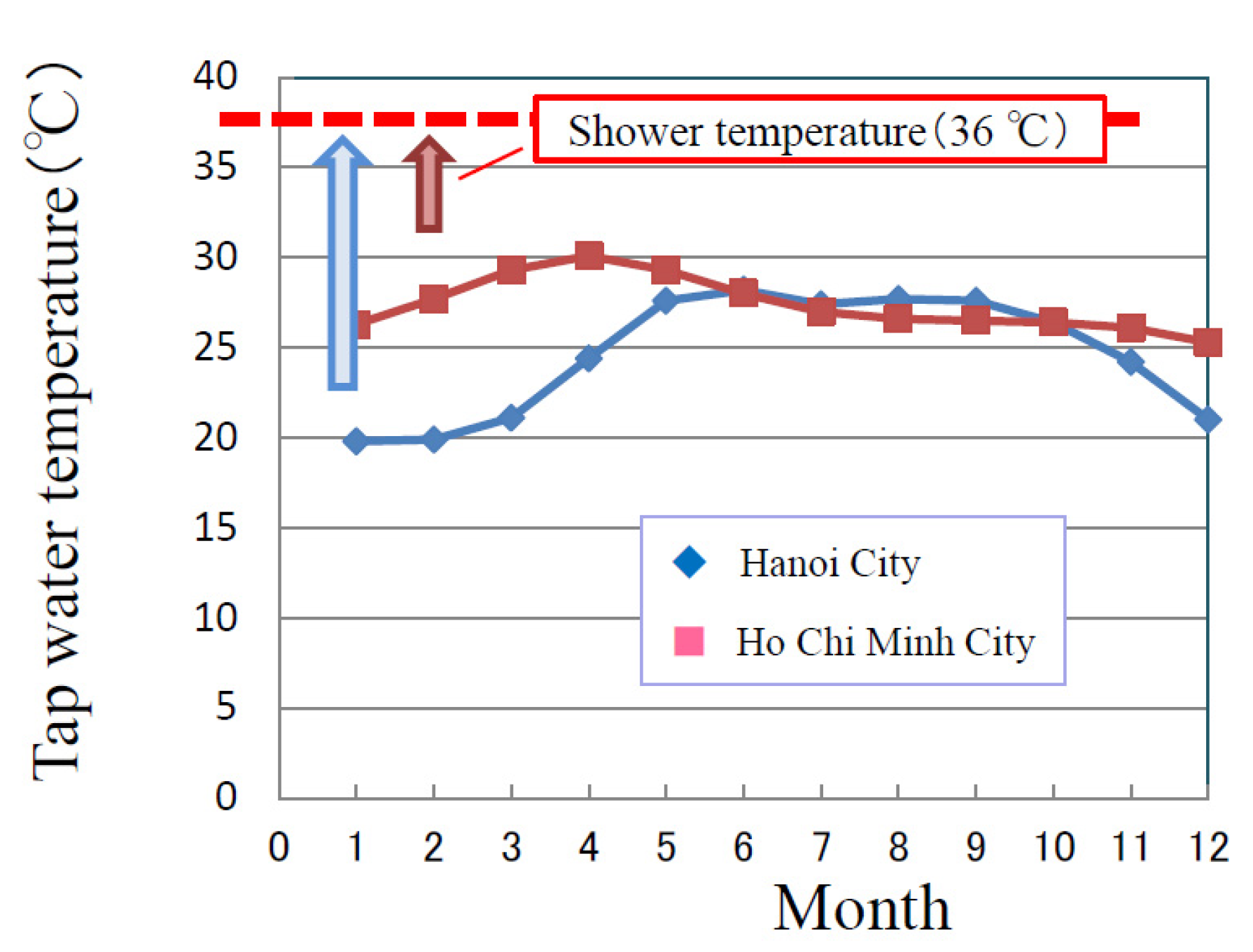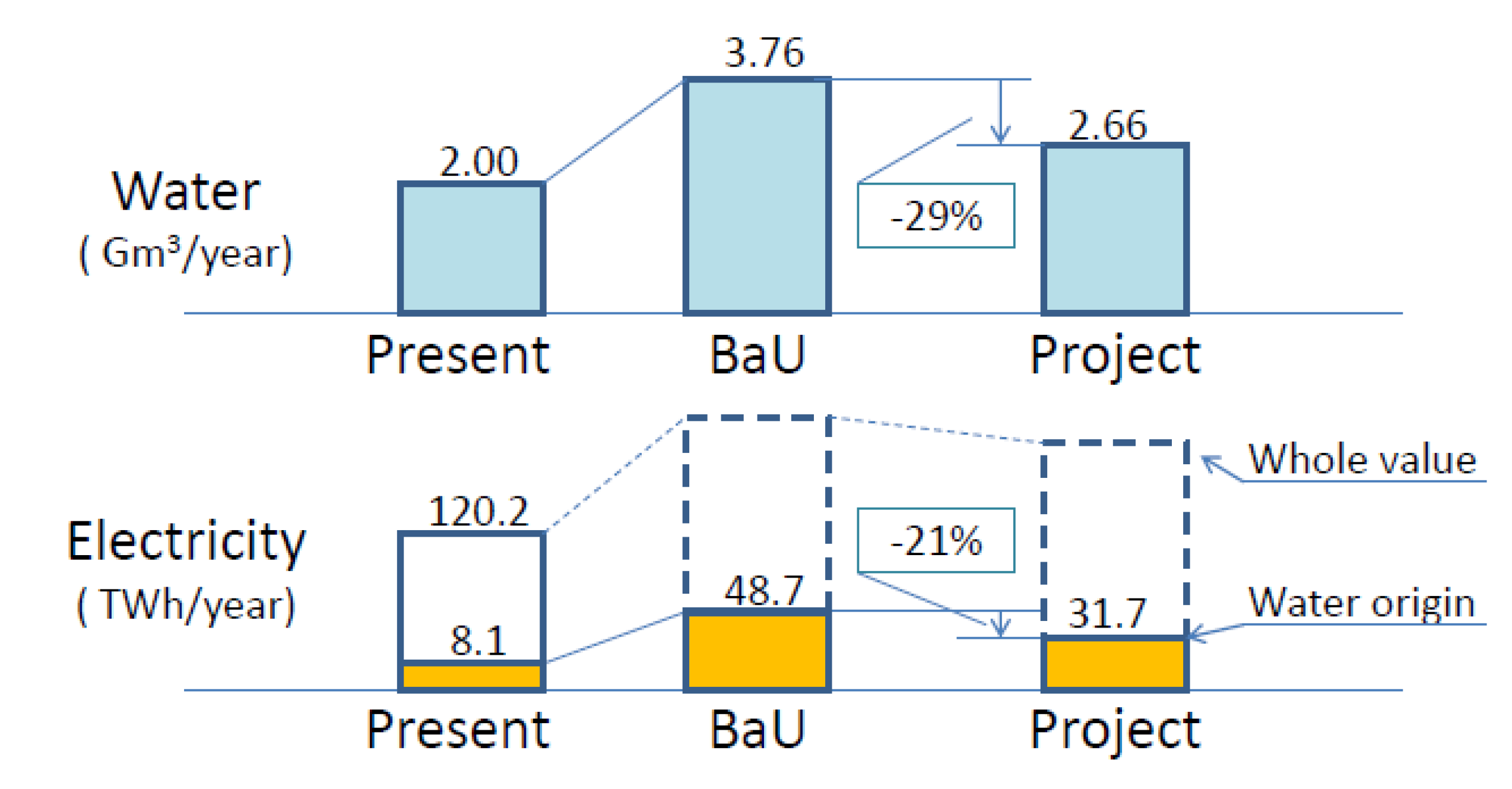Contribution of Water Saving to a Stable Power Supply in Vietnam
Abstract
:1. Introduction

2. Analysis
| Process | Energy Consumption Rate of Water (MJ/m3) |
|---|---|
| Waterworks system | 1.44 |
| Sewer system | 1.05 |
| Water supply system in a house | 1.99 |
3. Results and Discussion
3.1. Effect of Water Saving on Power Supply

| Item | Instantaneous Electric Water Heater | Storage Electric Water Heater |
|---|---|---|
| Appearance |  |  |
| Power consumption (W) | 4500 | 2500 |
| Max. supply temperature (°C) | 40 | 60 |
| Storage capacity (L) | 0 | 10–30 |


| Item | 2004 | 2006 | 2008 | 2010 | ||||
|---|---|---|---|---|---|---|---|---|
| Urban | Rural | Urban | Rural | Urban | Rural | Urban | Rural | |
| Refrigerator | 45.8 | 6.8 | 53.9 | 11.2 | 64.1 | 19.6 | 63.8 | 29.2 |
| PC | 16.3 | 1.3 | 21.3 | 2.6 | 28.9 | 4.8 | 38.2 | 7.6 |
| Television | 94.9 | 61.4 | 102.1 | 74.3 | 108.6 | 85.7 | 97.6 | 80.7 |
| Air-conditioner | 8.0 | 0.3 | 12.0 | 0.5 | 17.3 | 1.0 | 26.2 | 2.1 |
| Water heater | 18.0 | 1.1 | 22.5 | 2.0 | 26.6 | 3.8 | 28.9 | 6.3 |
3.2. Effect of Water Saving on Peak Load of Electricity Consumption

| Item | Refrigerator | PC | Television | Air-Conditioner | Water Heater |
|---|---|---|---|---|---|
| Electricity consumption (W) | 150–600 | 50–150 | 150–200 | 100–1000 | 2500–4500 |
4. Conclusions
Acknowledgments
Author Contributions
Conflicts of Interest
References
- Environment Agency. Greenhouse Gas Emissions of Water Supply and Demand Management Options; Science Report-SC070010; Environment Agency: Bristol, UK, 2008. [Google Scholar]
- Quantifying the Energy and Carbon Effects of Water Saving 2009. Available online: http://www.eauc.org.uk/quantifying_the_energy_and_carbon_effects_of_wa (accessed on 1 June 2015).
- Energy Use in the Provision and Consumption of Urban Water in Australia and New Zealand 2008. Available online: http://www.clw.csiro.au/publications/waterforahealthycountry/2008/wfhc-urban-water-energy.pdf (accessed on 1 June 2015).
- U.N.-Water Annual Zaragoza Conferences. Available online: http://www.un.org/waterforlifedecade/water_and_energy_2014/index.shtml (accessed on 1 May 2015).
- Shimizu, Y.; Toyosada, K.; Nakashima, K. Prediction of CO2 emissions associated with residential plumbing equipment. J. Soc. Heat. Air-Cond. Sanit. Eng. Jpn. 2010, 163, 11–18. [Google Scholar]
- Shimizu, Y.; Toyosada, K.; Yoshitaka, M.; Sakaue, K. Creation of carbon credits by water saving. Water 2012, 4, 533–544. [Google Scholar] [CrossRef]
- Otani, T.; Toyosada, K.; Shimizu, Y. CO2 reduction potential of water saving in Vietnam. Water 2015, 7, 2516–2526. [Google Scholar] [CrossRef]
- JETRO Hanoi, Vietnam Electricity Survey 2013. (In Japanese)Available online: http://www.jetro.go.jp/jfile/report/07001271/vietnamelectricity2013-2.pdf (accessed on 1 May 2015).
- Toyosada, K.; Shimizu, Y.; Iio, A.; Sakaue, K. Quantification of environmental impact reduction effect resulting from use of water-saving toilet bowls. J. Soc. Heat. Air-Cond. Sanit. Eng. Jpn. 2013, 193, 1–8. [Google Scholar]
- Toyosada, K.; Shimizu, Y.; Dejima, S.; Yoshitaka, M.; Sakaue, K. Evaluation of the potential of CO2 emission reduction achieved by using water-efficient housing equipment in Dalian, China. In Proceedings of the 38th International Symposium of CIB W062 on Water Supply and Drainage for Buildings, Edinburgh, UK, 28 August 2012; pp. 27–30.
- Kimura, H.; Hirose, A.; Toyosada, K.; Shimizu, Y.; Iio, A.; Sakaue, K. Study on the Modeling of the Bathing Behavior in Japan. In Proceeding of the Society of Heating, Air-conditioning and Sanitary Engineers of Japan, Sapporo, Japan, 5 September 2012; pp. 25–28.
- Vietnam Water and Sanitation Sector Assessment Report 2011. Available online: http://www.wpro.who.int/vietnam/topics/water_sanitation/watsan_sector_report_vietnam_2011.pdf (accessed on 1 May 2015).
- A committee to promote household energy efficiency and home security, Approach Book to promote household energy efficiency and home security 2006. (In Japanese)
© 2015 by the authors; licensee MDPI, Basel, Switzerland. This article is an open access article distributed under the terms and conditions of the Creative Commons Attribution license (http://creativecommons.org/licenses/by/4.0/).
Share and Cite
Otani, T.; Toyosada, K.; Shimizu, Y. Contribution of Water Saving to a Stable Power Supply in Vietnam. Water 2015, 7, 2900-2907. https://doi.org/10.3390/w7062900
Otani T, Toyosada K, Shimizu Y. Contribution of Water Saving to a Stable Power Supply in Vietnam. Water. 2015; 7(6):2900-2907. https://doi.org/10.3390/w7062900
Chicago/Turabian StyleOtani, Takayuki, Kanako Toyosada, and Yasutoshi Shimizu. 2015. "Contribution of Water Saving to a Stable Power Supply in Vietnam" Water 7, no. 6: 2900-2907. https://doi.org/10.3390/w7062900





